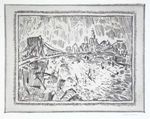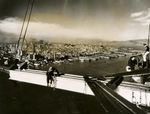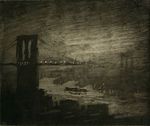Creeping Pavement: Depictions of an Urbanizing America
←
→
Page content transcription
If your browser does not render page correctly, please read the page content below
Creeping Pavement: Depictions of an Urbanizing America
Bowdoin College Museum of Art | Brunswick, Maine
April 9, 2021–January 30, 2022
In America, cities are places of contrast and connection. They bring people together, yet often
highlight the tensions that divide us. Cities are home to both the wealthy and the least privileged.
Inhabitants hail from near and far, yet all see themselves as a part of the city’s identity. Thus, the art
created when these urban centers developed offers a unique perspective on American life in the
nineteenth and twentieth century.
Tracing the evolution of the American city as it grew into its own distinct environment, this exhibition
explores the many ways artists reacted to the rapid urbanization of American life. From the landscapes
that foreshadow the industrialization and commercialization to come, to more recent urban views, the
selected works of art interrogate the concept of the city, asking: Where did the city come from? Who
was it intended for? How did it create and change the fabric of community? Artists highlight the many
different facets of a perpetually developing urban landscape, investigating the ever-changing qualities
that characterize the city today. The artists encourage us to look critically, quizzically, and lovingly at
big cities like New York, San Francisco, and Philadelphia. These images inspire us to find continuity
and to celebrate our shared humanity, even as we still grapple with the social, political, and
environmental ramifications of urbanity. If recent events have demonstrated the vulnerability and even
the fragility of cities and their inhabitants, these photographs from the past provide a powerful
reminder of their resilience.
This exhibition was curated by members of the 2019–2020 Student Museum Collective—Sylvia
Bosco ’21, Joseph Hilleary ’20, Cassie Jackson ’22, Sabrina Lin ’21, Ellie Sapat ’20, and Ben Wu ’18—
and is supported by the Becker Fund for the Bowdoin College Museum of Art.
CHARLES CODMAN
American, 1800–1842
Down East, 1838
oil on canvas
Gift of Mrs. Marshall P. Slade
1939.164
Charles Codman began his career as a sign painter and later gained acclaim as one of the earliest
landscape painters of the Maine wilderness. In Down East, two workers prepare an oxen wagon to
transport stacks of lumber presumably from the mill in the background. Such natural resources were
vital to inaugurating the process of industrialization and urbanization. The men are diminutive in size
as compared to the vast landscape around them. The dense, dark forests dwarf the men, hinting at the
threatening nature of untamed lands. During the nineteenth century, Americans were fascinated with
the rugged wilderness, but also strove to “conquer” and settle these “wild” places.
1Creeping Pavement: Depictions of an Urbanizing America
Bowdoin College Museum of Art | Brunswick, Maine
April 9, 2021–January 30, 2022
UNIDENTIFIED ARTIST
(Formerly attributed to GEORGE INNESS, American,
1825–1894)
View on the Hudson
oil on canvas
Gift of John H., Class of 1907, and Hannah Kellett Halford
1955.7
View of the Hudson captures the charm of a steamboat cruise on the Hudson River. Outfitted with
luxurious cabins, restaurants, and live music and promising a leisurely and rejuvenating vacation
through the “Rhine of America,” such trips were a popular outing for those who could afford it. Many
sought out the idyllic serenity of the Hudson River Valley and “the great outdoors” as a wondrous
escape from the hazards, overcrowding, and stress of the city. During the nineteenth century, writers
such as Ralph Waldo Emerson and artists such as Thomas Cole extolled the region’s natural beauty.
JOHN MARIN
American, 1870–1953
Brooklyn Bridge and Lower New York, 1913
etching
Museum Purchase, Elizabeth B.G. Hamlin Fund
1979.4
Born and raised in northern New Jersey, John Marin made New York City one of his favorite subjects.
In particular, the Brooklyn Bridge captured his imagination, and he pictured it repeatedly over more
than three decades beginning in 1911. This etching—likely influenced by European avant-garde
works on view at the 1913 Armory Show—demonstrates Marin’s early experimentation with cubism
and abstraction. Here, Marin represents the Brooklyn Bridge in harmony with the East River and
New York cityscape. Marin’s frenetic, dashed lines capture both the ordered chaos and invigorating
energy of the city he affectionately called home.
JOSEPH PENNELL
American, 1857–1926
Brooklyn Bridge at Night, 1922
aquatint
Gift of Miss Susan Dwight Bliss
1963.371
2Creeping Pavement: Depictions of an Urbanizing America
Bowdoin College Museum of Art | Brunswick, Maine
April 9, 2021–January 30, 2022
Though born in Philadelphia, Joseph Pennell spent most of his artistic career based in London
creating romantic illustrations of European cities. In 1921, Pennell returned to America and settled in
Brooklyn Heights, where he lived until his death. Pennell believed in the unique aesthetic qualities of
modern American cities, and his apartment afforded great views of the Brooklyn Bridge and the New
York skyline. While Pennell’s print foregrounds the bridge as a dark, hazy, and ominous structure, it
can also be understood as a longtime expatriate’s fond reflections on what makes American cities
distinct: namely, its immense verticality, unorthodox geometry, sweeping expanse, and modern
aesthetics.
UNIDENTIFIED PHOTOGRAPHER
American
Bridgeworkers on San Francisco—Oakland Bay Bridge, 11/17/1934
gelatin silver print
Gift of Isaac Lagnado, Class of 1971
2011.68.68
High above the water of San Francisco Bay, men work to piece together sections of steel on the Bay
Bridge. Although bridges literally function as an efficient solution to connect two places, this
photograph also showcases the sense of pride people felt in undertaking such a colossal project. Built
in the midst of the Great Depression, the bridge demonstrated the heights that American hard work
and ingenuity could achieve. The San Francisco Chronicle reported that on the bridge’s opening day
there was “the greatest traffic jam in the history of San Francisco, a dozen old-fashioned New Year’s
eves thrown into one.”
LEWIS WICKES HINE
American, 1874–1940
Steel Workers on Top of the Empire State Building Mooring Mast, 1930
gelatin silver print
Museum Purchase, Lloyd O. and Marjorie Strong Coulter Fund
1986.57
In this photograph, men rivet steel beams so high above the streets of New York that the other
buildings are out of focus. The workmen, in contrast, are in sharp focus and yet also similar in size to
the skyscrapers pictured below them. While this photograph might inspire awe and optimism about
the power of human ingenuity, Hine also encourages viewers to consider the danger involved in
constructing such iconic buildings. As a sociologist who used the camera to fight for social reform,
especially child labor laws, he provides in this image a new perspective of New York, one that asks us
to weigh our value of building incredible things against the value of the lives risked constructing them.
3Creeping Pavement: Depictions of an Urbanizing America
Bowdoin College Museum of Art | Brunswick, Maine
April 9, 2021–January 30, 2022
MAURICE BRAZIL PRENDERGAST
American, 1858–1924
Peaches Point, Mass (View from Old Burial Hill, Marblehead
(Barnegat) Massachusetts), ca. 1920–1923
watercolor, pastel, brush and colored ink
Gift of Mrs. Charles Prendergast
1991.13.2
While Prendergast’s post-impressionist style differed markedly from the urban realists associated with
the art group known as The Eight, he was invited to exhibit with them. Like William Glackens, whose
Captain’s Pier hangs nearby, Prendergast takes a coastal town as his subject, but turns its focus inward
toward community life rather than the sea. The village depicted here is Marblehead, Massachusetts, a
harbor town north of Boston. Absent from Prendergast’s work, though, is Glackens’s crowd of
tourists, replaced instead by a few seemingly local figures going about their daily business.
Prendergast’s bright colors and soft brush strokes give a dream-like quality to this tranquil setting, and
it stands in contrast to the darker depictions of city spaces in works such as Martin Lewis’ Shadow
Dance and Arnold Newman’s Walls and Ladders.
WILLIAM J. GLACKENS
American, 1870–1938
Captain’s Pier, 1912–1914
oil on canvas
Gift of Stephen M. Etnier, Honorary Degree 1969
1957.127
Glackens was a member of The Eight, a group of American painters based in New York that sought
to challenge the artistic establishment and bridge the gap between art and everyday life. This painting
is one of a series Glackens painted during visits to Bellport, Long Island, with his family between 1911
and 1916. His colorful palette and impressionist-inspired brush strokes imbue the painting with the
warm energy of a summer’s day. The well-dressed subjects crowding the docks with straw hats and
parasols represent affluent families who seek escape from the hustle and bustle of Manhattan.
Nevertheless, the congestion caused by these tourists disrupts the tranquility of the seaside town.
4Creeping Pavement: Depictions of an Urbanizing America
Bowdoin College Museum of Art | Brunswick, Maine
April 9, 2021–January 30, 2022
MARTIN LEWIS
American, 1881–1962
Shadow Dance, 1930
drypoint
Gift of Miss Susan Dwight Bliss
1963.323
Martin Lewis was an Australian-born printmaker who worked in newspaper illustration and is noted
for the striking use of dark shadows that give his works a film noir-like effect. In Shadow Dance,
clusters of backlit female figures, identifiable by their almost ethereal translucent skirts, dominate the
frame, their individual features fading almost into silhouette forms while long shadows stretch before
them. These figures are juxtaposed with the intense glow seemingly radiating outward from the heart
of the city. The clean streets, tall buildings, and the women’s short dresses and cloche hats signal a new
urban modernity then emerging in American cities during the 1920s.
JOHN SLOAN
American, 1871–1951
A Window on the Street, 1912
oil on canvas
Bequest of George Otis Hamlin
1961.50
In 1904, John Sloan moved from Philadelphia to New York to nurture his artistic career and in time
became associated with the Ashcan School, a group of modern artists who aimed to portray the life of
everyday Americans. In this painting, Sloan turns viewers away from the street and instead asks us to
consider those who inhabit the city. Sloan focuses our attention solely on a young woman looking out
her window. The contrast of her pale skin and the darker, less visible interior of her apartment creates
a sense of melancholy. In comparison to Martin Lewis’ Shadow Dance, on view nearby, which
highlights the bright vitality of the street, A Window on the Street depicts how a city can be an isolating
place.
5Creeping Pavement: Depictions of an Urbanizing America
Bowdoin College Museum of Art | Brunswick, Maine
April 9, 2021–January 30, 2022
BERENICE ABBOTT
American, 1898–1991
Daily News Building, 42nd Street between 2nd and 3rd Avenue, 1935
gelatin silver print
Museum Purchase, Gridley W. Tarbell II Fund
1994.16
This photograph is part of Berenice Abbott’s “Changing New York” series, created through support of
the Works Project Administration during the Great Depression. From this lofty viewpoint, Abbott
captures the strikingly modern skyline of New York, including the Daily News Building, which was
completed in 1930. While her contemporary Lewis Hine foregrounds the people building these
structures, Abbott instead focuses on capturing the new perspectives that such buildings now afford.
The grid lines of the city and the tilted angle of the photograph emphasize the height and sprawl of
New York—it is huge, and it is growing. In the background, smoke billows up from factories,
highlighting the ongoing “progress” of the city.
ARNOLD NEWMAN
American, 1918–2006
Wall & Ladders, Philadelphia, PA, 1939 (printed ca. 1940s)
gelatin silver print
Museum Purchase, Gridley W. Tarbell II Fund
2010.48
Taken towards the end of the Great Depression, this photograph captures the decaying infrastructure
of a city without extinguishing hope for its future. Arnold Newman is best known for his portraits of
well-known people, works in which he defines his subjects through their surrounding environment.
Here the photographer offers a portrait of the city of Philadelphia itself, capturing its character
through cracks, ladders, and contrasting tones. In the midst of crumbling buildings, the dark
silhouettes of two men appear against the light concrete wall. While the photograph shows a rundown
city in need of repair, it also expresses a sense of optimism, which extends not only to the city but
seems to radiate outward to the country as a whole: two men are already at work to fix the problem.
6Creeping Pavement: Depictions of an Urbanizing America
Bowdoin College Museum of Art | Brunswick, Maine
April 9, 2021–January 30, 2022
J. H. LOCHER
American, active nineteenth century
Untitled (map of New York and Brooklyn)
color lithograph
Bequest of William H. Alexander
2003.11.48
This sweeping bird’s eye view captures the bustling vitality of New York City in the 1850s, offering a
snapshot of Lower Manhattan, Brooklyn, and Governor’s Island prior to the city’s expansion in the
years after the Civil War. Tall buildings and church towers are presented alongside commercial docks,
encompassing the activity and industry that characterized the young metropolis. Published by J. H.
Locher, the composition was modelled after a lithograph originally drawn by John Bachmann, a Swiss-
American artist whose signature aerial views incited contemporary interest in urban landscapes.
Bachmann utilized a fabricated vantage point to convey at once the vastness and density of this new
urban center. A noteworthy detail is the inclusion of Castle Garden at the end of a pier, which became
the first U.S. immigration station in 1855.
YVONNE JACQUETTE
American, born 1934
Study for World Trade Center, New York Harbor (Looking
South), 1977
pastel
Gift of Alex and Ada Katz
1986.115.3
In the early 1970s, Yvonne Jacquette created aerial views with heightened colors that captured the
spirit of modernity. Jacquette’s work appears to reflect a fascination with oblique vantage points, often
chartering planes and going to the tops of skyscrapers to sketch the view from above. In this pastel
study, Jacquette positioned herself on top of the South Tower of the World Trade Center, looking
down at New York Harbor, the islands stretching far into the horizon. The dramatic elevation and
endless repetition of boats, buildings, and crisscrossing structures illustrate the scope of a greater
urban network. Jacquette’s vibrant palette instills the landscape with a buoyant atmosphere, while her
distinct, densely packed marks visually echo the city’s energy, dynamism, and life.
7You can also read



























































